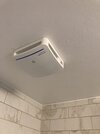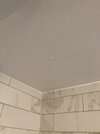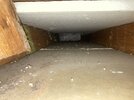Hi all,
I have an extractor fan in our shower room, directly above the shower cubicle- recently installed a DMEV type fan which all works well in terms of extracting the steam at least. This vents into uninsulated foil ducting, which in turn is attached to a vented tile on the roof.
What I didn't realise was a problem is condensation in the ducting- I've only noticed it the last day or so where the temperature has dropped and it is dripping both back through the fan, and the ceiling where the ducting runs.
I've therefore done some googling today and it would appear that ideally I need to use rigid ducting, and a condensate trap? I don't have much roof space above, due to the dormer roof configuration, and just thought I'd ask for any additional advice on here as to how best to approach it? I was looking at just cutting a section of plasterboard out above the cubicle, doing the above, and then the condensate pipe can go through the soffit/facia?
As said any advice on better (or easier) solutions, or just confirming above appreciated. I suspect my biggest issue is going to be lack of space between the roof tiles and the shower room ceiling, and what is a very short run of ducting. Second photo shows where the dripping is coming through, and last photo is of the roof above (slight pitch over the dormer- vent tile is just underneath left hand velux in the photo. The dormer window to the left is the shower room, and cubicle is against the exterior wall pretty much right below the vent tile).
I have an extractor fan in our shower room, directly above the shower cubicle- recently installed a DMEV type fan which all works well in terms of extracting the steam at least. This vents into uninsulated foil ducting, which in turn is attached to a vented tile on the roof.
What I didn't realise was a problem is condensation in the ducting- I've only noticed it the last day or so where the temperature has dropped and it is dripping both back through the fan, and the ceiling where the ducting runs.
I've therefore done some googling today and it would appear that ideally I need to use rigid ducting, and a condensate trap? I don't have much roof space above, due to the dormer roof configuration, and just thought I'd ask for any additional advice on here as to how best to approach it? I was looking at just cutting a section of plasterboard out above the cubicle, doing the above, and then the condensate pipe can go through the soffit/facia?
As said any advice on better (or easier) solutions, or just confirming above appreciated. I suspect my biggest issue is going to be lack of space between the roof tiles and the shower room ceiling, and what is a very short run of ducting. Second photo shows where the dripping is coming through, and last photo is of the roof above (slight pitch over the dormer- vent tile is just underneath left hand velux in the photo. The dormer window to the left is the shower room, and cubicle is against the exterior wall pretty much right below the vent tile).
Attachments
Last edited:





